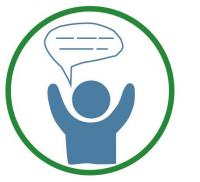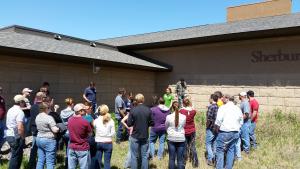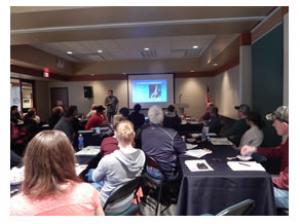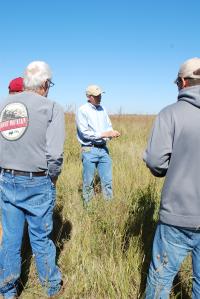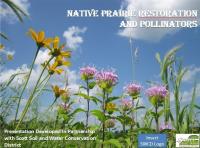Introduction
Community outreach and involvement is a key part of increasing awareness about the importance of conservation efforts and engaging landowners and other partners. Outreach can also play a key role in educating landowners and providing them with the information that they need to be good land stewards. This outreach can take many forms including discussion groups, workshops, training events, volunteer events, landowner discussions, lesson plans, news articles, radio program, website content, brochures and posters. Keys to effective outreach and public engagement include effective listening, ensuring that all viewpoints are heard, having sincere and honest discussions, finding common ground, finding direct ways that information can be implemented, and perhaps most importantly, finding ways that the public can be part of the solution. Conservation projects can be great opportunities to increase interactions within communities and to have a cause for landowners to rally behind. More inclusive and strengthened communities can result in addition to a healthier environment.
Additional information about strategies for public involvement in natural resources management can be found in the Scott County/University of Minnesota publication titled: Inspiring Action for Nonpoint Source Pollution Control.
Planning Methods and Programs
Communication plans. Developing a communication plan can help focus your message and reach your target audience. A plan can also influence the efficiency and simplicity of your communication methods and help determine what strategies will be most effective to use to engage intended audiences.
Key Strategies
- Landowner involvement in projects. Finding ways to engage landowners in projects within urban or rural communities can be an important way to promote conservation efforts. This can be accomplished through volunteer events, tours or promoting community gatherings where projects are featured. Having landowners speak about the benefits of projects on their property can be an effective method of convincing other landowners to sponsor projects.
- Discussion groups. Communication within small groups can be an effective way to discuss specific landscape issues and define needs for larger discussion that may include workshops, training, and other forms of outreach. Environmental issue forums such as the set of forums and supporting tools, and training developed by the North American Association for Environmental Education allow for structured discussions about complex environmental topics.
- Workshops. Workshops can take many forms ranging from facilitated meetings between community members and elected officials to share ideas to focused events designed to strategize future direction. Workshops provide opportunities to increase dialog between a wide range of parties interested in a particular topic. It is important that workshops are planned to allow for all viewpoints to be heard and that clear outcomes are set for what is to be learned.
- Training events. Issues related to landscape resilience and climate adaptation can often be combined with training events focused on a wide range of natural resource topics ranging from water quality concerns to restoring plant diversity and pollinator habitat. It is beneficial to have “hands-on” training, such as having participants consider specific solutions for their landscape or work directly with landscape planners/designers in small groups.
- Volunteer Events. Having volunteers involved in natural resource projects can be great opportunities to increase awareness about issues while building community and increasing the workforce for projects. Organizing volunteer events can take additional time but can have long-term benefits.
- Landowner discussions. Discussions with landowners can occur in a wide range of places including kitchen tables, offices, fairs, and public events. Direct discussions with landowners are important to understand their concerns as well as their perspectives about potential solutions. Landowners can also play a very important role in promoting best practices to other landowners.
- Lesson plans. There are many opportunities to discuss topics related to landscape health within classrooms. The EPA has a website that includes lesson plans and other teacher resources.
- News articles. Developing press releases about projects that are being done to address landscape concerns can be an effective way to highlight the benefit of projects while also educating the public about natural resource concerns.
- Radio programs. Like newspaper articles, radio interviews are a good opportunity to discuss project details and raise public awareness. Some conservation professionals become regular hosts on local radio stations.
- Website Content. Websites are a good opportunity to present case studies of projects designed to increase landscape resilience and climate adaptation. Before and after images can be a particularly compelling aspect of case studies to demonstrate the benefits of specific projects.
- Brochures and Posters. A variety of printed materials can be used to highlight projects or concerns that landowners should be aware of. The poster to the right, developed by USDA, is a good example of targeted outreach to educate landowners about the value of conservation practices to prevent erosion from large storms.
- Case Studies
The Scott Soil Water & Conservation District (SWCD) has held workshops that led to significant public participation in prairie restoration
Slide from a presentation developed by Scott SWCD projects. The SWCD advertised through newspapers, flyers posted at city halls, grocery stores, other public places, and on the web. The majority of those that attended planned to convert their lawns to native flowers and grasses, while some are converting crop land or pasture to native vegetation. Participants were interested in planting native plants and providing pollinator habitat but didn’t know where to start. A variety of information was presented, including information about the benefits of native plants and prairies. A landowner presented on the benefits of planting native prairie. Sponsors from local seed suppliers and consultants, a bee farm, some townships and other organizations also participated. The workshops received positive responses and the majority of participants wanted to go ahead with projects.
The East Metro Water Resource Education Program (EMWREP) is a partnership formed in 2006 that serves 24 local units of government in the east metro area. The purpose of the shared education program is to provide education about the impacts of nonpoint source pollution on local lakes, rivers, streams, wetlands and groundwater resources and to engage people and communities in projects that will help to protect and improve water quality in the region. Interested homeowners (also businesses, churches and schools) learn about Blue Thumb (coordinated planting for clean water marketing efforts) through EMWREP outreach activities (neighborhood parties, workshops, presentations and news articles). In 2012, the Minnesota Association of Watershed Districts recognized EMWREP as its Program of the Year.

